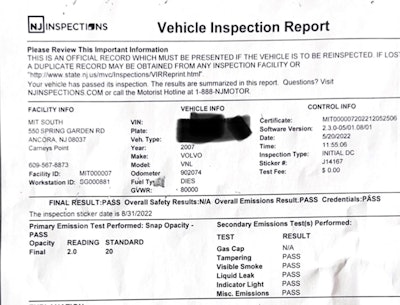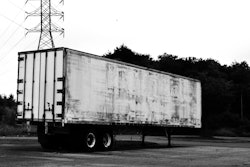
Several times a year it seems we hear of shop owners and even some truck owners who have been caught out of emissions compliance, whether gutting the hardware of the internal emissions-system components and/or reprograming the truck’s electronic control module with black-market tuning. The notion that puts these kinds of practices in demand is that a deleted emissions system will reduce the owner’s cost of maintenance and operation. We read the stories on social media, we hear the gossip related to the testing of truck exhaust for emissions. We complain of the overreach of regulations and government controls.
A small percentage of drivers threaten shutdowns in online forums, and the arguments between drivers end up taking centerstage -- while the original subject or solution seems to be lost in the discussion.
It all reminds me of a bygone but no less relevant era in trucking, when it was common to be pitched over the CB radio on this kind of logic: Retune your ECM, you’ll have 600-700 horsepower and more available. It takes just 15 minutes, you'll haul more miles, faster.
It always sounded like a recipe for some kind of disaster for the truck owner, in my mind.

Fast-forward to our current operating environment. We’re to the point that some locales outside California are actually testing exhaust at scale houses. I’m far from certain about just where this is happening in total, but in addition to the usual culprit out west, New Jersey has been cited by owners I’ve spoken with.
Owner-operator David Nihart hauls regularly to Jersey out of the Midwest and back. Perhaps surprisingly, his case was the very first time he had seen any such emissions test being conducted at the scale house near Carneys Point, New Jersey. Researching this, I received a message from another owner who lives in Maryland who was tested at this same location about a year ago. They also passed the testing.
Going into it, Nihart felt some anxiety, as one could easily anticipate. Fortunately, his personal knowledge of his 2007 Volvo 870, owned for 2.5 years and with 902,000 miles on a Cummins ISX 15-liter that has never been in-framed (much less deleted), helped him maintain his focus.
Meeting him at the scale with a brief introduction were state emissions-inspection staff, generally polite and professional. Nihart asked how much time it would delay him as he was headed toward a time-sensitive expedite customer. The staff led him through this process:
- He was asked to present his cab card/registration, VIN and engine serial number.
- The inspection staff did a quick visual inspection but did not ask to have the hood opened. (Nihart said he believed inspectors were looking for exhaust and possibly fluid leaks.)
- Before the testing phase, Nihart decided to turn off his air conditioner, and this allowed his fan clutch to disengage.
- The EPA staff placed a sensor attached to a pole into his exhaust pipe.
- Then, he was asked to increase the RPMs. Nihart described the request to be to depress the accelerator to the floor. He decided not to say a word, but only to take his RPMs to 1,500 and hold there until the test was complete, and the inspector did not question this.
- The whole inspection took about five minutes, and when completed David received a copy of a report, noting that he passed, and a sticker to place in his windshield indicating the truck was tested in the second quarter of 2022 and in compliance.
[Related: Deleting emissions problems without deleting the system]
I sensed overall relief listening to Nihart’s narration of events -- pride, too, that his equipment passed this fast yet simple test, an indication that the truck he owns is being well-maintained and operating efficiently, particularly as every owner is saddled with trying to operate profitably and stretch every mile out of their fuel.
Nihart’s initial message about all of this to me reflected that, too: Well, that was an experience! Just got emissions tested in New Jersey! Passed with flying colors! Just finished sending positive feedback and thanks to my mechanic!
Wanting to learn more, and attempting to figure out in what states these roadside exhaust tests are routinely conducted, I contacted the U.S. EPA office in the Chicago region. I found that there may be the possibility you will see this testing sporadically as individual state agencies receive funding.
 This map shows areas throughout the country where an inspection and maintenance program for registered vehicles, whether basic or more in-depth, is in place -- some states are required to have these programs by the Clean Air Act, others not so. As noted in the caption for this graph in this report at EPA's website, "although not required, some states have included light-duty diesel vehicles as part of I/M programs, while others are beginning to conduct I/M for heavy-duty diesel vehicles as well."
This map shows areas throughout the country where an inspection and maintenance program for registered vehicles, whether basic or more in-depth, is in place -- some states are required to have these programs by the Clean Air Act, others not so. As noted in the caption for this graph in this report at EPA's website, "although not required, some states have included light-duty diesel vehicles as part of I/M programs, while others are beginning to conduct I/M for heavy-duty diesel vehicles as well."
When I read the tea leaves, so to speak, it’s not a far stretch to think trucking may begin seeing additional random testing or requirements for annual emissions in the coming years as the push toward a so-called zero-emissions-equipment goal continues.
Where will this leave owners with older trucks? Could we experience the regulatory creep of the rules being implemented in California, with companies scrambling and placing orders with truck manufacturers for the new EVs, or growing potential for hydrogen engines?
Time will tell on that front, yet historically small business owners tend to be followers when these major shifts occur. That’s easy to understand, knowing the huge capital outlay investment in brand-new technology most often requires, likewise the personal pride many owners take in maintaining current equipment, no matter what age.
I suggest to owners large or small that before you go fully negative, stay informed and work though the information. As I coach my clients to do: seek out the truth, don’t just react emotionally.
Change is inevitable, and the problem one person sees as impossible to overcome will be easy to solve and benefit from for another.
[Related: How politics and PR cloud 'zero emissions' reality]










